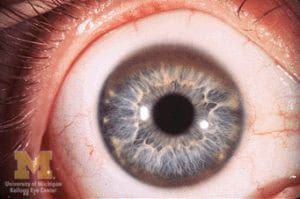Wilson Disease: the rare, autosomal (meaning it occurs in both men and women), recessive (meaning that an individual must inherit one copy of the mutated allele from each parent to express the condition) disease can sometimes be diagnosed by looking at someone’s eyes!

When Wilson Disease has led to neurological involvement, most people will have deposits of copper visible in their eyes. These rings are brown to greenish-gold and are known as Kayser-Fleischer Rings. Sometimes they can be seen by an opthamologist directly, but they are easier to detect using a slit lamp.
These rings can be produced by a few other rare medical conditions and so they are not in themselves, a confirmation of Wilson Disease. Lab tests are required to confirm the diagnoses.
In addition, about twenty percent of patients who have neurologically symptomatic Wilson Disease, another ocular indication is found; a sunflower shaped cataract.
Wilson disease can be treated with chelating agents such as trientine or d-penicillamine, which help remove the excess copper from the body. Over time, the copper that has been deposited in the eyes can be lessened and the Kayser-Fleischer ring fades. People with Wilson disease must remain on medication for the rest of their lives to keep copper levels within acceptable limits.
Sometimes a low dose of a chelating agent and zinc is also commonly used to help prevent copper absorption. Some individuals, because of extensive damage to the liver, or because medications are not keeping copper levels at an acceptable level, must undergo liver transplantation. This cures Wilson disease but requires lifetime anti-rejection medication.
Talk about another good reason to get your eyes checked!


